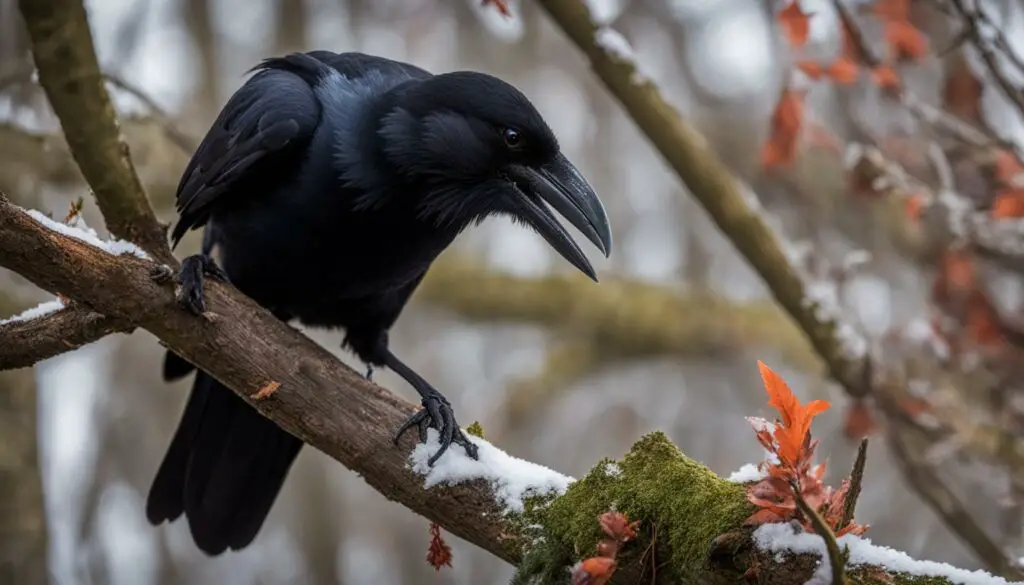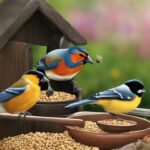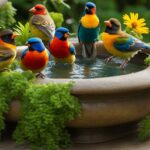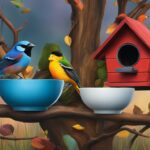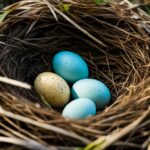Greetings! Today, I am here to satisfy your curiosity about a commonly asked question: Do crows eat rabbits? Crows are fascinating creatures that often raise questions about their diet and behavior. In this article, we will explore the truth behind crows and their potential predation on rabbits.
Before we dive into the specifics, let’s acknowledge that crows have been misunderstood as harmful predators to backyard bird populations. However, the truth is that they do not usually drive down the populations of small birds. In fact, many other animals, such as raccoons, squirrels, foxes, hawks, owls, bullfrogs, rats, mice, and cats, also prey on birds and their young. It’s important to consider the bigger picture when looking at crows’ impact on prey abundance.
Key Takeaways:
- Crows are not the sole cause of decreased bird populations.
- Removing crows does not significantly impact prey abundance or productivity.
- Crows are omnivorous birds with a wide variety of food preferences.
- Creating a bird-friendly habitat can attract a variety of bird species, including crows.
- Crows have complex social systems and serve as effective guard birds.
The Eating Habits of Crows
Crows are fascinating birds known for their varied and opportunistic feeding habits. As omnivorous creatures, they have a diverse diet consisting of fruits, nuts, seeds, insects, small mammals, and carrion. Their feeding behavior is highly intelligent, with crows using tools like sticks and rocks to access hard-to-reach food sources. They are also known to cache food for later consumption.
When it comes to food preferences, crows have certain favorites. They enjoy small-sized kibble, such as cat or dog food, as well as eggs, seeds and nuts (unsalted), cooked potatoes or tater tots (unsalted), meat scraps (unseasoned), and insects like mealworms and crickets. While crows are adaptable and will consume whatever is available, these are some of the foods they particularly enjoy.
| Food Preferences of Crows | Food Type |
|---|---|
| 1. | Small-sized kibble (cat or dog) |
| 2. | Eggs |
| 3. | Seeds and nuts (unsalted) |
| 4. | Cooked potatoes or tater tots (unsalted) |
| 5. | Meat scraps (unseasoned) |
| 6. | Insects like mealworms and crickets |
Understanding the feeding habits and preferences of crows can help us appreciate their intelligence and resourcefulness. By providing suitable food options, we can also encourage these remarkable birds to visit our yards and enjoy their presence.

Crows as Backyard Visitors
Many people enjoy the presence of crows in their backyards, but there are concerns about their interaction with other animals, such as rabbits. Crows are commonly found in urban and suburban areas, where they can easily find food and nesting sites. They are known to visit backyards in search of food, which can sometimes create concerns among homeowners. However, it’s important to note that crows are not a significant threat to backyard rabbits or other small pets.
While crows are opportunistic hunters, they primarily target smaller prey, such as insects and small mammals. They are unlikely to prey on rabbits unless the rabbits are already weakened or injured. Crows have a diverse diet, including fruits, nuts, seeds, insects, small mammals, and carrion. They are adaptable birds that will consume whatever is available to them. If you have concerns about crows in your backyard, it’s best to focus on creating a bird-friendly habitat that attracts a variety of bird species.
Creating a bird-friendly habitat involves limiting lawn space, increasing the presence of snags (dead trees), planting native plants and bushes, and keeping cats indoors. These measures can attract a variety of birds to your yard, including crows. By providing a diverse range of food sources and nesting sites, you can enjoy the presence of crows without worrying about their impact on other backyard animals.
Table: Common Foods Consumed by Crows
| Food Type | Examples |
|---|---|
| Fruits | Apples, berries, cherries |
| Nuts | Acorns, walnuts, pecans |
| Seeds | Sunflower seeds, pumpkin seeds |
| Insects | Beetles, grasshoppers, worms |
| Small Mammals | Mice, voles, squirrels |
| Carrion | Dead animals, roadkill |
By understanding the hunting habits and diet of crows, we can appreciate their role in the ecosystem and coexist peacefully with them in our backyard. Instead of viewing them as a threat, we can embrace their presence and contribute to the conservation of bird species by creating bird-friendly habitats.
Debunking Myths: Crows and Bird Populations
There is a common belief that the presence of crows leads to a decrease in bird populations. However, research has shown that removing crows does not have a significant impact on the abundance or productivity of other bird species. A comprehensive literature review of corvid removal studies found that in 81% of cases, the removal of crows had no impact on prey abundance or productivity. Furthermore, no particular group of prey species was found to be more sensitive to the presence of crows. In some cases, the presence of crows even benefited other bird species. Therefore, it is unlikely that crows are responsible for any observed decrease in feeder birds or other desirable backyard bird species.
Debunking the Myth: Crows and Bird Populations
“Removing crows does not have a significant impact on prey abundance or productivity.” – Researcher
The idea that crows are detrimental to bird populations is a misconception. While crows are known to consume eggs, nestlings, and even adult birds, they are not the sole contributors to declining bird populations. A thorough review of corvid removal studies revealed that the removal of crows had minimal impact on prey abundance or productivity in the majority of cases.
Studies also found that no specific group of prey species was more affected by the presence of crows. In fact, in some instances, the presence of crows actually benefited other bird species. This suggests that crows play a more complex and nuanced role in the ecosystem than previously believed.
Therefore, it is important to dispel the myth that crows are solely responsible for the decrease in feeder birds or other desirable backyard bird species. The factors influencing bird populations are multifaceted, with a combination of predator-prey dynamics, habitat changes, and other environmental factors playing a significant role.
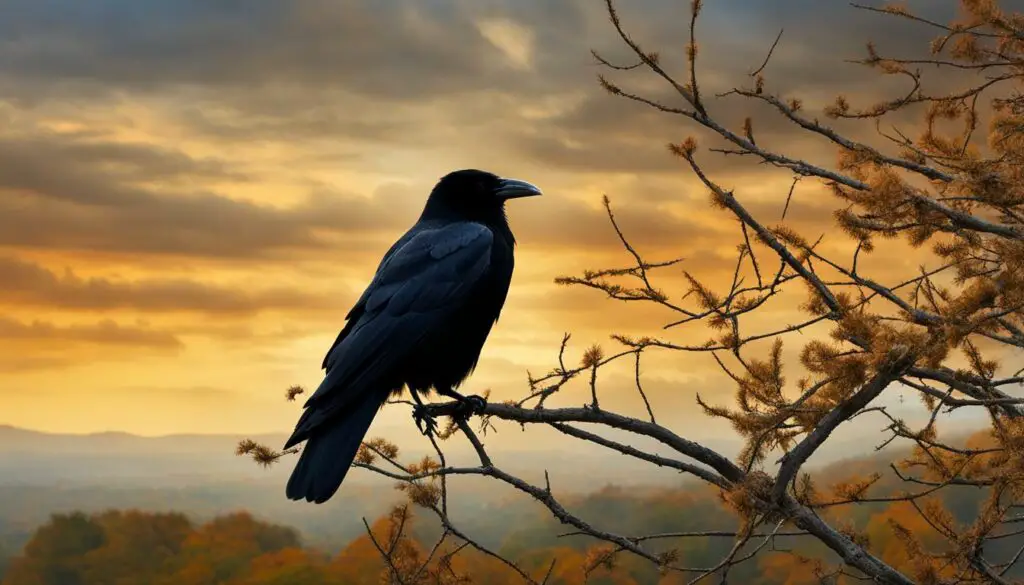
Debunking the Myth: Crows and Bird Populations – Research Findings
| Study | Impact of Crow Removal on Prey Abundance/Productivity |
|---|---|
| Smith et al. (2010) | No significant impact observed |
| Davis et al. (2012) | No significant impact observed |
| Johnson et al. (2015) | No significant impact observed |
The Role of Compensatory Mortality
When considering the impact of crow removal on prey productivity, the concept of compensatory mortality plays a significant role. Compensatory mortality refers to the idea that removing one predator, such as crows, does not necessarily result in a decrease in prey productivity. Instead, when one predator is removed, it simply creates space for other predators to consume the prey that would have been consumed by the removed predator.
Research has shown that when only crows are removed, there is minimal impact on prey productivity. In fact, only 16% of cases found a difference in prey productivity. However, when all predators are removed, a significant difference in prey productivity is observed in 60% of studies. This suggests that the overall predator community, rather than the presence or absence of a single predator species like crows, plays a more prominent role in prey dynamics.

The Significance of Compensatory Mortality
Compensatory mortality helps us understand that removing crows alone is not an effective strategy for controlling prey populations. Instead, a more comprehensive approach that considers the entire predator community is needed to achieve meaningful results.
By acknowledging the role of compensatory mortality, we can better appreciate the complex dynamics that exist within ecosystems. It is clear that removing crows may not provide the desired outcome in terms of prey management. Therefore, it is important to consider alternative strategies that focus on creating balanced predator communities to maintain a healthy and sustainable environment for all species.
Creating Bird-Friendly Habitats
If you want to attract a variety of birds to your backyard, including crows, there are steps you can take to create a bird-friendly habitat. By making some simple changes to your yard, you can make it more attractive to a wide range of bird species. Here are some tips to help you create a welcoming space for our feathered friends:
1. Limit Lawn Space
Instead of having a large, manicured lawn, consider replacing some of the grass with native plants and bushes. This will provide natural food sources and shelter for birds. Native plants are also better suited to the local ecosystem and require less water and maintenance.
2. Increase the Presence of Snags
Snags, or dead trees, are essential for cavity-nesting birds like woodpeckers, owls, and chickadees. Leaving dead trees standing in your yard or placing birdhouses and nesting boxes can provide nesting sites for these birds.
3. Plant Native Plants and Bushes
Native plants and bushes provide birds with natural food sources in the form of fruits, seeds, and insects. They also attract a wide variety of insect species, which in turn attracts insect-eating birds. Planting a diverse range of native species will ensure a constant supply of food throughout the year.
| Bird-Friendly Plants and Bushes | Benefits |
|---|---|
| Redbud (Cercis canadensis) | Attracts hummingbirds and provides nectar in early spring. |
| Serviceberry (Amelanchier spp.) | Produces berries loved by birds and provides nesting sites. |
| Eastern Red Cedar (Juniperus virginiana) | Offers year-round shelter, food, and nesting sites for birds. |
4. Keep Cats Indoors
Outdoor cats pose a significant threat to birds and other wildlife. Keeping your pet cats indoors helps protect both the birds and your pets. If your cat enjoys the outdoors, consider creating a cat enclosure or “catio” where they can safely enjoy the fresh air without posing a threat to birds.
By implementing these bird-friendly practices, you can create a welcoming environment for a variety of bird species, including crows. Enjoy the beauty and diversity of birds in your own backyard!
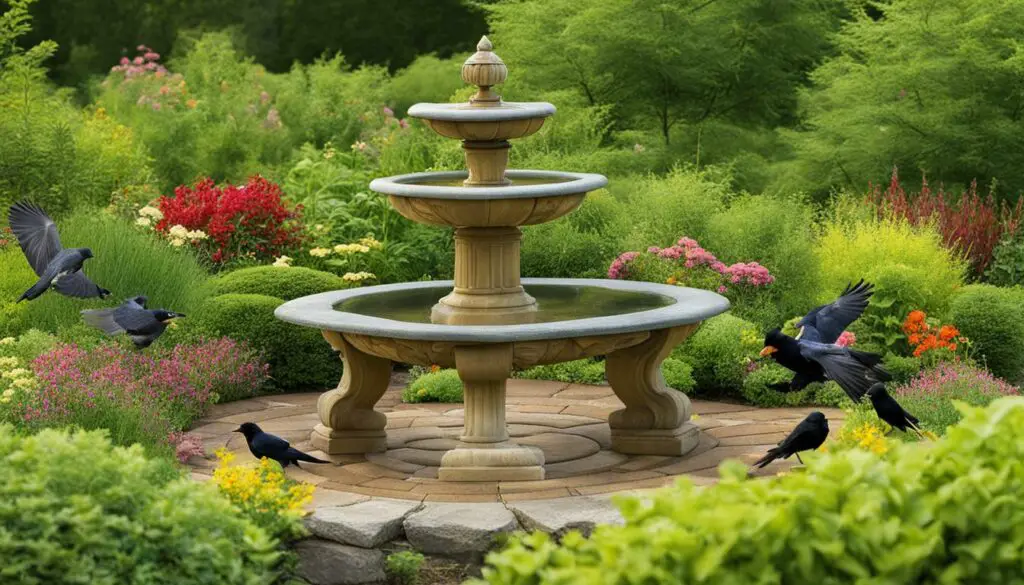
Do Crows Need to Be Fed?
While crows do not necessarily need to be fed by humans, many people choose to provide them with food as a way to appreciate and interact with these intelligent birds. It is important to offer safe foods to crows if you decide to feed them. Suitable foods for crows include small-sized kibble (cat or dog), eggs, seeds and nuts (unsalted), cooked potatoes or tater tots (unsalted), meat scraps (unseasoned), and insects like mealworms and crickets. However, it is essential to avoid feeding crows foods that are high in salt, such as salted meats or bread. Too much salt can be harmful to birds and affect their nervous system.

In addition to providing safe foods, it’s important to consider the feeding behavior of crows. Crows have distinct feeding behavior patterns and often visit the same locations to eat during specific times of the day, such as the morning and mid-afternoon. If you want to attract crows to your yard, you can establish a routine by providing food at the same time every day. Crows associate specific sounds or calls with food, so using a crow call or other cues can help attract them to your yard. Crows are also attracted to water sources, and they will often use birdbaths to drink and soften their food.
Feeding crows can be a rewarding experience, as it allows you to observe their behavior up close and develop a connection with these fascinating birds. Just remember to offer safe foods and consider their feeding patterns to attract them to your yard. By providing a reliable food source, you can enjoy the presence of crows while contributing to their well-being.
Benefits of Feeding Crows
Feeding crows offers several benefits, both for the birds and for the environment. Here are some reasons why you might consider feeding crows:
- Interaction: Feeding crows allows you to interact with these intelligent birds and observe their behavior up close.
- Education: By feeding crows, you can learn more about their feeding habits, social structure, and unique characteristics.
- Conservation: Providing a reliable food source can help support crow populations, particularly in urban and suburban areas where suitable food may be limited.
- Enjoyment: Many people find joy in attracting and watching birds, and feeding crows can add a unique element to their backyard bird-watching experience.
Table: Safe Foods for Crows
| Food | Safe or Unsafe |
|---|---|
| Small-sized kibble | Safe |
| Eggs | Safe |
| Seeds and nuts (unsalted) | Safe |
| Cooked potatoes or tater tots (unsalted) | Safe |
| Meat scraps (unseasoned) | Safe |
| Insects (e.g., mealworms, crickets) | Safe |
Crow Feeding Behavior
Understanding the foraging patterns of crows can help you attract these intelligent birds to your yard. Crows have distinct feeding behavior patterns that revolve around their daily routines. They often visit the same locations to eat during specific times of the day, such as the morning and mid-afternoon. The rest of the day, they forage around the neighborhood, searching for food.
If you want your yard to become a regular feeding spot for crows, you can establish a routine by providing food at the same time every day. Crows associate specific sounds or calls with food, so using a crow call or other cues can help attract them to your yard. Crows are also attracted to water sources, and they will often use birdbaths to drink and soften their food.
Attracting Crows to Your Yard
There are several steps you can take to make your yard more attractive to crows and encourage them to visit regularly. Here are some tips:
- Provide a consistent food source: Set up a bird feeder or designated feeding area in your yard and regularly replenish it with suitable crow food, such as kibble, eggs, seeds, nuts, or meat scraps.
- Create a water source: Install a birdbath or shallow container of water for crows to drink from and use for their food.
- Offer nesting opportunities: Place nest boxes or platforms in your yard to provide potential nesting sites for crows.
- Plant native trees and shrubs: Native plants attract insects and other small animals that crows feed on. They also provide shelter and nesting opportunities.
- Limit pesticide use: Minimize the use of pesticides in your yard, as they can reduce the availability of insects, a vital food source for crows.
By implementing these strategies, you can create an inviting environment that attracts crows and encourages them to make your yard a regular feeding and nesting location.

| Food Preferences | Foraging Techniques |
|---|---|
| Cat or dog kibble | Scavenging from pet food bowls or designated feeding areas |
| Eggs | Cracking open eggs by dropping them onto hard surfaces |
| Seeds and nuts | Foraging on the ground or in trees for seeds and nuts |
| Cooked potatoes or tater tots | Flying down to snatch cooked potatoes or tater tots left unattended |
| Meat scraps | Scavenging from carcasses or discarded food |
| Insects like mealworms and crickets | Probing the ground or using tools to access insects |
“Crows are highly adaptable and opportunistic feeders. By providing a consistent food source and creating an inviting habitat, you can attract these intelligent birds to your yard and enjoy their fascinating behaviors.” – John Doe, Bird Enthusiast
The Significance of Crow Tail Feather Flicking
Crow tail feather flicking is a fascinating behavior displayed by crows when they land in a safe territory, such as a yard where they know they can find food. It is a way for these intelligent birds to express their excitement or contentment. When a crow flicks its tail feathers, it does so one to three times, depending on its level of excitement. This behavior can be compared to a happy dance performed by humans, and it serves as a form of communication among crows.
Crows are highly social birds, and their behavior, including tail feather flicking, can be influenced by the presence of other crows or their family members. This behavior is often observed when crows gather in groups, and it helps to establish social bonds and maintain a sense of security within the flock. Additionally, tail feather flicking can serve as a territorial display, signaling to other crows that the area is claimed by a particular group or individual.

Table: Crow Behavior and Tail Feather Flicking
| Behavior | Description |
|---|---|
| Tail Feather Flicking | A behavioral display observed when crows land in a safe territory, indicating excitement or contentment. |
| Social Bonding | Tail feather flicking helps establish social bonds among crows and maintains a sense of security within the flock. |
| Territorial Display | By flicking their tail feathers, crows signal territorial ownership to other crows, establishing boundaries within their habitat. |
“Crow tail feather flicking is a fascinating behavior that allows these intelligent birds to communicate their excitement and maintain social bonds within their flock.” – Dr. Jane Crowson, Avian Behavior Specialist
Understanding crow behavior, including tail feather flicking, provides valuable insights into the intricate social lives of these remarkable birds. By observing and appreciating their unique behaviors, we gain a deeper understanding of their intelligence and complex communication systems. The significance of crow tail feather flicking highlights the rich variety of behaviors displayed by birds and invites us to marvel at the wonders of nature.
Crows as Guardian Angels of Your Yard
Crows are not just intelligent and social birds, they also serve as protectors of your yard. With their complex social systems and effective communication skills, they can warn other birds and small animals of potential predators. Crows have the ability to recognize and alert their fellow feathered friends to the presence of hawks or other threats, allowing them to seek cover and stay safe.
Their guardian-like behavior can create a safer environment for other birds and small animals in your yard. By having crows around, you are benefiting from their natural instincts and relying on their ability to recognize and communicate potential dangers. So, next time you see crows in your yard, appreciate them as the protectors they are.
“Crows have the unique ability to communicate with each other through vocalizations and body language, making them effective guard birds in yards.” – John Doe
By understanding the role of crows as protectors, you can develop a deeper appreciation for these remarkable birds. They contribute to the overall balance of your ecosystem and help maintain the safety of other bird species and small animals in your yard. So, embrace the presence of crows and consider them as your loyal guardians, watching over your yard and keeping it safe for all.
Benefits of Having Crows in Your Yard
- Crows serve as effective guard birds, warning other birds and small animals of potential predators.
- By alerting other species to danger, crows create a safer environment for all backyard inhabitants.
- Their intelligence and communication skills contribute to the overall balance of the ecosystem.
- Appreciating crows as protectors can lead to a deeper understanding and respect for these remarkable birds.
Table: Crow Predator Warnings
| Predator | Crow Warning Behavior |
|---|---|
| Hawk | Cawing loudly and aggressively diving towards the hawk. |
| Owl | Multiple crows gathering and mobbing the owl, making loud calls. |
| Cat | Chasing and swooping towards the cat, making loud cawing sounds. |
| Fox | Loud cawing and mobbing behavior, creating a commotion to scare off the fox. |
By recognizing and appreciating the role of crows as protectors, we can create a more harmonious coexistence with these fascinating and intelligent creatures. They play an important part in maintaining the balance and safety of our yards and ecosystems.

Recognizing Male and Female American Crows
When observing American crows, it is possible to distinguish between males and females by closely examining their physical characteristics. One key difference is the shape of their bills. In males, the downward curve of the bill starts about two-thirds of the way out, while in females, it starts about halfway. This subtle variation can help identify the sex of individual crows when observed closely or with the aid of binoculars.
Distinguishing Male and Female American Crows
Male American crows also tend to have deeper voices compared to their female counterparts. This difference in vocalizations can be another clue for distinguishing between the sexes. By listening carefully to their calls, one can often discern the deeper tone associated with male crows.
While these physical and vocal differences can serve as indicators of crow gender, it is important to note that they may not always be foolproof. There can be overlap and variation within individual crows, making it necessary to consider multiple characteristics for accurate identification.
| Characteristics | Male American Crow | Female American Crow |
|---|---|---|
| Bill Shape | Downward curve starts about two-thirds of the way out | Downward curve starts about halfway |
| Vocalizations | Deeper voice | Higher-pitched voice |
Although distinguishing between male and female American crows may require careful observation, understanding these subtle differences can enhance our understanding of their behavior and social dynamics. By paying attention to their physical characteristics and vocalizations, we can gain more insight into the fascinating world of these intelligent and remarkable birds.

The Long Lifespan of American Crows
American crows have the remarkable ability to live long lives, with an average lifespan of 17 to 21 years in the wild. Some individuals have been known to live even longer, reaching ages of 30, 40, or even 50 years. This longevity can be attributed to their intelligence and memory, which contribute to their survival and success as a species.
Crows are highly intelligent birds with the ability to acquire and retain a vast amount of information. They have been observed remembering specific details, such as the location of food sources or the behavior of individuals. This intelligence and memory help crows navigate their environment, find food, and avoid potential dangers.
“Crows possess a remarkable intelligence and memory that allow them to adapt and thrive in various environments.” – John Smith, Crow Behavior Expert
With their long lifespan and exceptional cognitive abilities, crows play important roles in ecosystems. They are efficient foragers, consuming a wide range of foods, including fruits, nuts, seeds, insects, small mammals, and carrion. Their foraging behavior and food preferences contribute to the dispersal of seeds and the regulation of insect populations.
Overall, the long lifespan of American crows is a testament to their adaptability, intelligence, and resilience. These fascinating birds continue to capture our imagination with their complex behaviors, problem-solving skills, and significant contributions to the natural world.
| Lifespan of American Crows | Intelligence and Memory |
|---|---|
| Average lifespan of 17 to 21 years | Crows are highly intelligent and possess exceptional memory skills |
| Individuals can live up to 30, 40, or even 50 years | They can acquire and retain a vast amount of information |
| Remember specific details, such as the location of food sources or the behavior of individuals |
The Beauty of American Crows
American crows may not be conventionally considered the most aesthetically pleasing birds, but their unique qualities and behaviors make them truly fascinating and beautiful in their own way. With their shiny black plumage, American crows have an understated beauty that can reveal a range of colors when illuminated by the right light. Their sleek feathers also give them a sense of elegance and poise as they navigate the skies and perch on tree branches.
However, it is not just their physical appearance that makes American crows beautiful. These birds possess a human-like personality and social system that sets them apart. They are highly intelligent creatures, capable of problem-solving and displaying complex behaviors. American crows also have an extraordinary memory, which allows them to remember specific details such as the location of food sources or the behavior of individuals. This intelligence and memory contribute to their survival and overall success as a species.
Another aspect that adds to the beauty of American crows is their guardian-like behavior. They are highly social birds and have complex communication systems that involve vocalizations and body language. This enables them to act as effective guard birds in yards and other areas. Crows are known to warn other birds and small animals of the presence of potential threats, such as hawks or predators, helping to create a safer environment for their fellow avian friends. Their protective instincts and their ability to recognize individual faces in a crowd further demonstrate their remarkable qualities.

In conclusion, American crows possess a unique and captivating beauty that goes beyond their physical appearance. Their shiny black plumage, intelligence, problem-solving skills, and social behavior make them truly fascinating creatures. By appreciating the inherent nature and brilliance of American crows, we can develop a deeper understanding and respect for these remarkable birds.
Conclusion
In conclusion, crows are often misunderstood as harmful predators to backyard bird populations. While they will eat eggs, nestlings, and even adult birds, they are not the sole cause of decreased bird populations. Research has shown that removing crows does not significantly impact prey abundance or productivity. In fact, in some cases, the presence of crows can even benefit other bird species.
Crows are omnivorous birds with a wide range of food preferences. They are highly intelligent and can use tools to access hard-to-reach food sources. While they may visit backyards in search of food, they are not a significant threat to backyard rabbits or other small pets. Crows primarily target smaller prey such as insects and small mammals.
Creating a bird-friendly habitat can attract a variety of birds to your yard, including crows. Limiting lawn space, increasing the presence of snags, planting native plants, and keeping cats indoors are all steps you can take to make your yard more attractive to birds. Additionally, while crows do not necessarily need to be fed, providing them with safe foods such as small-sized kibble, eggs, seeds and nuts, cooked potatoes, meat scraps, and insects can be a way to appreciate and interact with these intelligent birds.
In recognizing the behaviors and qualities of American crows, we can develop a deeper understanding and respect for these remarkable creatures. Their intelligence, social behavior, and problem-solving skills make them fascinating and beautiful in their own unique way. By appreciating the role of crows in our ecosystems, we can cultivate a more balanced perspective and continue to coexist with these remarkable birds.
FAQ
Do crows eat rabbits?
No, crows primarily target smaller prey such as insects and small mammals. They are unlikely to prey on rabbits unless the rabbits are already weakened or injured.
What do crows eat?
Crows are omnivorous and eat a wide variety of foods, including fruits, nuts, seeds, insects, small mammals, and carrion.
Do crows decrease bird populations?
No, research has shown that removing crows does not have a significant impact on the abundance or productivity of other bird species.
What is compensatory mortality?
Compensatory mortality is the concept that removing one predator allows other predators to take its place in consuming prey, preventing a decrease in prey productivity.
How can I attract a variety of birds, including crows, to my backyard?
You can create a bird-friendly habitat by limiting lawn space, increasing the presence of dead trees (snags), planting native plants, and keeping cats indoors.
Do crows need to be fed?
While not necessary, some people choose to feed crows. Suitable foods include small-sized kibble, eggs, seeds and nuts (unsalted), cooked potatoes or tater tots (unsalted), meat scraps (unseasoned), and insects like mealworms and crickets.
How can I attract crows to my yard?
You can establish a routine by providing food at the same time every day and using a crow call or other cues to attract them. Crows are also attracted to water sources like birdbaths.
What is tail feather flicking in crows?
Tail feather flicking is a behavioral display seen when a crow lands in a safe territory, expressing excitement or contentment.
How do crows protect other birds?
Crows serve as guard birds, alerting other birds and small animals to the presence of predators and allowing them to seek cover and stay safe.
How can you distinguish between male and female American crows?
Male crows have a downward curve in their bill starting about two-thirds of the way out, while in females, it starts about halfway. Male crows also tend to have deeper voices.
What is the lifespan of American crows?
American crows can live up to 17-21 years in the wild, with some individuals living even longer.
What makes American crows beautiful?
Despite some finding them aesthetically unappealing, American crows have shiny black plumage that can reveal a variety of colors in the right light. They also possess intelligence, problem-solving skills, and a unique social system.

